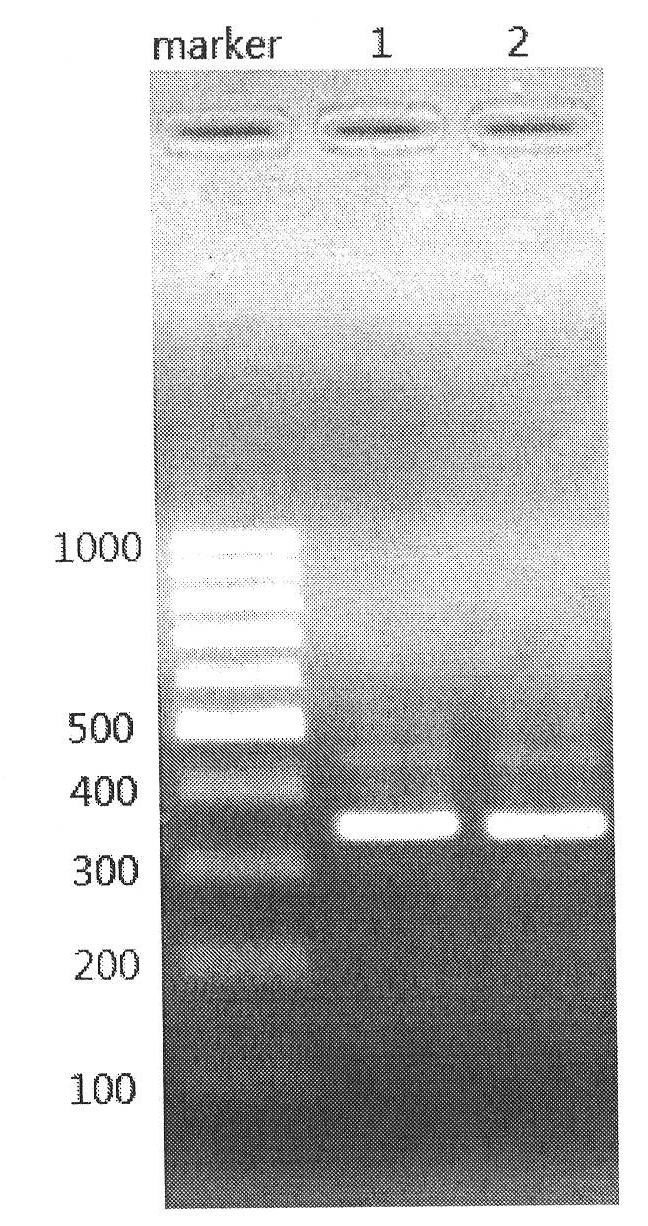Recombinant molecule of human immunodeficiency virus film molecule gp120 functional domain and human TGF (Transforming Growth Factor)-beta1
A TGF-, virus technology, applied in antiviral agents, recombinant DNA technology, medical preparations containing active ingredients, etc., can solve the problems of non-specificity, high immunogenicity, large gp120 molecule, etc., and achieve easy purification and recovery. , the effect of high purity and high protein expression
- Summary
- Abstract
- Description
- Claims
- Application Information
AI Technical Summary
Problems solved by technology
Method used
Image
Examples
Embodiment 1
[0037] Example 1 Acquisition of hmTGF-β1 and C2-C4-Linker DNA Fragments
[0038] 1. C2-C4-Linker DNA fragment
[0039] Peripheral blood mononuclear cells were isolated from patients with epidemic HIV-1 infection in China, total RNA was extracted by Trizol (purchased from invitrogen), and cDNA was obtained by reverse transcription with reverse transcriptase superscript III (purchased from invitrogen), guided by cDNA template and specific primers Next, PCR amplifies the DNA fragment in the C2-C4 region. Specific primers (synthesized by Shanghai Yingjun): upstream primer: 5'-CGCAGGATCCTCTGTCAATTTCACGG-3, which introduces an endonuclease BamHI site; downstream primer: 5'-ACGCGTCGACATACATTGCTTTTCCT-3, which introduces an endonuclease SalI site. Reaction conditions: pre-denaturation at 98°C for 3 minutes, 30 cycles at 98°C for 30s, 50°C for 30s, and 72°C for 60s, and finally extension at 72°C for 10 minutes. Gel recovery kit (purchased from Shanghai Jierui) purified and recovered ...
Embodiment 2
[0043] Example 2 Construction and Identification of hmTGF-β1 and C2-C4-Linker Cloning Plasmids
[0044] Both phusion high-fidelity DNA polymerase and pfx Tag DNA polymerase are blunt-ended clones. After adding A to the end of hmTGF-β1 and C2-C4-Linker PCR products using common Tag DNA polymerase, T4 DNA ligase is used to connect to pCR2. 1-T cloning vector, transformed into competent cells DH5α, selected positive monoclonal strains by blue-white screening, placed in LB medium (containing 50mg / ml ampicillin), cultured at 37°C for 16-18h, and extracted a small amount of plasmid for enzyme digestion identification. The constructed plasmids were named pCR2.1-hmTGF-β1 and pCR2.1-C2-C4-Linker respectively. Select the Apal restriction endonuclease site in both the T vector and hmTGF-β1 sequences to identify pCR2.1-hmTGF-β1 by single-enzyme digestion, and identify pCR2.1-C2-C4-Linker by double-enzyme digestion with BamHI and SalI. See the results separately image 3 and Figure 4 ,...
Embodiment 3
[0045] Example 3 Construction and Identification of Prokaryotic Expression Vector of C2-C4-Linker-hmTGF-β1 Recombinant Molecule
[0046] BamHI and SalI double digestion plasmid pCR2.1-C2-C4-Linker, recover the target DNA fragment C2-C4-Linker, SalI and XhoI double digestion plasmid pCR2.1-hmTGF-β1, recover the target DNA fragment hmTGF-β1, The linearized prokaryotic expression vector pET-28a was digested with BamHl and XhoI, and T4 DNA ligase was used to connect C2-C4-Linker and hmTGF-β1 to pET-28a, transform BL21 (DE3) competent cells, and coat LB homologous medium ( Containing 25mg / ml kanamycin) plates were cultured at 37°C for 16h, picked a single colony in LB medium (containing 25mg / ml kanamycin), and cultured for 16-18h on a shaker at 37°C vigorously, a small amount Extract the plasmid and name it pET-C2-C4-L-hmTGF-β1. BamHI digestion identifies the recombinant plasmid pET-C2-C4-L-hmTGF-β1. 1.5% agarose gel electrophoresis shows a band at about 700bp (See Figure 5 ), w...
PUM
 Login to View More
Login to View More Abstract
Description
Claims
Application Information
 Login to View More
Login to View More - R&D
- Intellectual Property
- Life Sciences
- Materials
- Tech Scout
- Unparalleled Data Quality
- Higher Quality Content
- 60% Fewer Hallucinations
Browse by: Latest US Patents, China's latest patents, Technical Efficacy Thesaurus, Application Domain, Technology Topic, Popular Technical Reports.
© 2025 PatSnap. All rights reserved.Legal|Privacy policy|Modern Slavery Act Transparency Statement|Sitemap|About US| Contact US: help@patsnap.com



